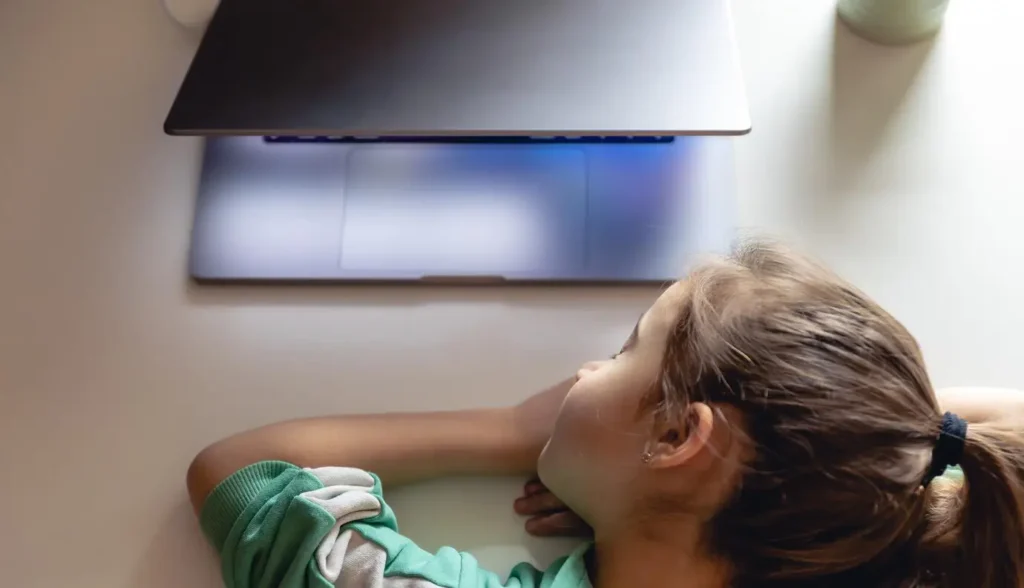Balancing Technology with Health: Tips for Reducing the Negative Effects of Electric Devices
Finding a way to balance this need with our relationships and wellness in today’s tech-driven world can be difficult. Electric devices have changed how we live and work—from smartphones to laptops—but just like anything else, they have drawbacks. This blog post provides invaluable guidance on reducing the negative impacts of extended screen usage and transforming your technology habits to enhance your overall well-being. Let’s dive in!

Technology has been crucial in our lives in the recent decade; however, electric devices harm human health.
Many technological advances have become inseparable from our daily lives, with mobile phones, computers, tablets, and other devices becoming indispensable tools at home and in the workplace. Technological advancements have been associated with many potential benefits and conveniences, but have they impacted our health?
Over time, there has been a dramatic increase in the number of electronic devices being used, with an average of 11 hours a day spent looking at a screen. Too much screen time negatively impacts our physical, mental, and emotional health. However, with the rise of technology came new challenges in living a healthy lifestyle, such as eye strain, posture issues, sleep disturbances/insomnia, and social isolation.
The ever-increasing use of technology considerably affects health, especially regarding a sedentary lifestyle. Thanks to the proliferation of electronic devices, more people live sedentary lifestyles than ever. Instead of participating in sports or playing outside, individuals are glued to screens for long hours. Such a lifestyle can disrupt a healthy life and cause illnesses such as obesity, coronary artery disease, diabetes, and certain cancers.
Another worrisome component is how technology affects sleep habits. The blue light that devices emit stifles melatonin production, the hormone that governs the sleep-wake cycle. This can lead to insomnia or low-quality sleep, as using these devices near bedtime can disrupt sleep rhythms.
Moreover, the side effect of being constantly engaged with electric devices harms our mental health. Despite its popularity, spending too much time on social media and comparing yourself to others’ highlights can lead to negative emotions like loneliness and anxiety.
Excessive screen time can also overexert your eyesight, causing headaches and dry eyes. Technological Influence on Our Health But we should all remember: technology is not inherently bad. It is how we use it and how much time we spend engaging with screens that define its effects on our well-being.”
The following sections include practical advice on mitigating electric devices’ negative impact on us. Only by integrating technology and health can we help technology continue to advance, but we must not forget that we also need to take care of ourselves.
Why Electric Devices Can Be Bad For Your Health
As technology increasingly permeates our daily lives and the usage of electronic devices rises, it is essential to make out the potential health risks associated with them. Smartphones, laptops, tablets, televisions, and gaming consoles are all sources of EMRs, which may harm our health.
Eye strain is one of the most common adverse effects of electric devices on health. Extended periods spent in front of electronic devices without taking breaks or changing the brightness can result in dire consequences for eye health, such as myopia and cataracts.
In addition, extended use of smartphones and handheld devices has been associated with a higher risk of developing musculoskeletal disorders (MSDs). Cutting the neck at nearly 90 degrees, a fixed position of neck pain and stiffness, and even causing permanent spinal problems. Likewise, long typing sessions with small keyboards can cause hand cramping and carpal tunnel syndrome.
Other than physical side effects, electric devices also affect our mental health. These gadgets provide constant connectivity and contribute to stress and anxiety. Being constantly reachable and having to react right away to messages or notifications is hard on mental health. Studies have also compounded this, linking excessive computer use with poor sleep quality due to interruption of melatonin production.
Moreover, EMR generated from electronic devices has been associated with several health issues, including DNA damage, induced cellular stress response, and hormonal disruptions. This is especially worrisome for children exposed at a young age while their bodies still develop.
To mitigate the potential negative effects of EMR from electronic devices on their health, individuals will have to minimize their risks of exposure. Among these are protective cases and screen filters, reducing screen time, and using devices in bright places. Limiting screen time and having a digital detox also help with mental well-being.
Electric devices make our lives very convenient and efficient, but knowing their negative impact on our health is essential. Understanding these dangers and minimizing exposure leads to a healthier relationship between tech and us.

Blue light exposure and your sleep patterns
With the rise in the use of smartphones, laptops, and tablets, blue light exposure has become a hot topic in recent years. These devices also use blue light, significantly affecting our sleep patterns.
What exactly is blue light, and how does it affect our sleep? Blue light originates from both natural sunlight and artificial sources like LED screens. It possesses shorter wavelengths and more incredible energy than other colors in the spectrum. It is found in natural sunlight and produced by electronics with LED screens. Exposure to blue light between 5 a.m. and 7 p.m. increases mood, greater perceived alertness, and productivity. But if we experience it at night, it can interfere with our body’s natural sleep-wake cycle.
Our bodies possess an internal mechanism known as the circadian rhythm, which influences our sleep patterns. This clock responds to environmental signals like light or darkness to know when we feel sleepy or alert. Nighttime exposure to blue light inhibits the production of melatonin, a hormone essential for sleep. Then our bodies do not get the signal that it is bedtime, and it is harder for us to fall asleep.”
Moreover, studies have found that blue light exposure at night can negatively impact sleep quality. The deep stages of sleep, with their associations with REM (rapid eye movement) and NREM (non-rapid eye movement) sleep, are critical stages that restore physical and mental health. However, too much blue light exposure at night can inhibit our ability to enter these stages correctly, resulting in poor sleep quality.
So, how can we mitigate the damaging effects of blue light exposure on our sleep? First, restrict screen time before bed. Limit the use of electronics at least one hour before you plan on sleeping. Instead, opt for calming pursuits such as diving into a good book or enjoying tranquil music.
Also, use the settings on your electronic devices to limit the amount of blue light emitted. Most offer a” night mode” or a” blue light filter,” which can be turned on at specific times to lessen the effect on our sleep.
Get yourself a pair of blue light-filtering glasses. These lenses specifically pull out blue light so you can produce more melatonin and sleep without difficulty.
So, while tech has provided intense convenience and connection, we must consider how it could impact our health. Steps like adjusting your screen time and getting blue-light-blocking glasses are simple ways to create harmony between your use of technology and your sleep schedule.
Orthopedic Issues due to gadget usage
With the rise of digital gadgets, it is no surprise that we use electric devices extensively for professional work and entertainment. These devices are forcing their way into our lives, from smartphones to laptops. However, posture-related issues have also increased as we spend more time using our laptops or smartphones.
Sustained device use can develop bad posture habits that harm us. We hunch over electronic devices or lean forward to see the screen. This constant stress on our neck and upper back muscles could develop into multiple musculoskeletal problems.
“Text neck” is one widespread posture problem caused by extended device use. It is the stress and strain on the neck when we repeatedly look down at our phones or tablets. The typical human head weighs around 10-12 pounds, but when tilted forward at a 45-degree angle—such as when looking at a phone—it exerts roughly 49 pounds of pressure on the spine. These postural changes can create muscle imbalances and increase the strain on the cervical spine over time.
Another problem caused by excessive use of electronic devices is the “tech neck.” This happens when we hunch in front of a PC or laptop for prolonged periods without adequate posture support. Sitting with the torso 80° reclined (as you would have when typing or using the mouse) places pressure on the lower spine and compresses the discs between vertebrae, which can lead to chronic lower back pain.
Besides the conditions closely associated with technology use, extended device usage can contribute to poor posture, such as rounded shoulders and diminished core strength. However, these ailments harm our physical health and can impact our emotional well-being. Several studies have shown that bad posture correlates with low self-esteem and mood disorders.
The good news is that several options are available to alleviate the negative impact of prolonged device use on posture:
- 1) Take breaks often. Set a timer to stretch every 30 minutes. This will relieve strain on the neck and back muscles.
- 2) Maintain good posture—If you use devices, be conscious about how you sit. Keep your head neutral, and don’t slouch or hunch over.
- 3.) Ergonomic devices – An ergonomic keyboard, mouse, or laptop stand can reduce strain on the hands, wrists, and shoulders.
- 4) Incorporate stretches into your daily routine. In particular, stretch those areas impacted by extended device use: the neck, upper back, and chest muscles.
However, consider the potential for posture-related issues arising from excessive device use. We can take active measures to prevent them, ensuring we can maintain our physical well-being while using technology. Have you ever felt tired from being in front of the screen for several hours?
Mental health issues stemming from technology use
Issues regarding the mental health impact of technology use have gradually increased. As our lives become increasingly connected through electronic devices, it is little wonder that we see adverse consequences for our mental health. Technology can impact our mental health significantly (mostly, it is negative) when used in excess, from social media comparison to tech addiction.
One of the most significant issues regarding technology use is its impact on self-esteem and body image. Instead, social media is populated with perfectly curated posts and photos that can provoke feelings of lack and low self-esteem when we compare ourselves with other people. Research has linked heavy social media use with symptoms of depression, anxiety, and body dissatisfaction.
Furthermore, electronic devices provide an addictive level of stimulation that also increases the expected level of stress and anxiety. Notifications, emails, and all sorts of messages flood our environment with incessant demands for attention, making complete relaxation difficult for our brains. Over time, the constant feeling of being on high alert contributes to fatigue, irritability, difficulty concentrating, etc, which eventually takes a toll on our mental health.
A different worry has been the risk of addiction to electronic devices. When technology brings new information to our fingertips, instant gratification comes in the form of likes, comments, or anything else, so it becomes all too easy to get addicted to checking our phones or other devices. Not only does this subtract from face-to-face conversation, but it has also become associated with withdrawal symptoms when deprived of access to these gadgets.
In addition, the negative impact of excessive screen time on sleep patterns is well-documented, with possible repercussions for physical and mental health. Poor sleep hygiene has been linked to emotions, lack of concentration and productivity, and greater vulnerability to anxiety or depression.
We all must take some measures to mitigate the negative influences that technology could contribute to our mental health. One strategy is to limit device use, such as taking breaks from screens during the day or creating “technology-free” zones in homes. Disconnecting from technology for a period each day can also enhance our overall well-being by reducing stress levels from the technological advances we employ.
Further, mindfulness practices such as deep breathing techniques or meditation can help control technology-driven anxiety and stress. Also, use time off from electronics to do other things, like go outside, exercise, or visit family to catch up face-to-face.
Technology is excellent, but we must also consider how it can affect our mental health. Connecting the dots is the key: Moderation is also essential.

How to Minimize Harm from Electric Home Devices
With the speed at which technology advances, it is hard to envision everyday jobs without electric devices. These devices are vital to our lives, from phones to laptops to tablets and televisions. But alongside those conveniences and capabilities come a raft of health effects that should raise eyebrows.
Limit Screen Time:
If there is one thing we can do to minimize the negative implications of electric devices, this is it. Prolonged screen exposure may result in eye fatigue, headaches, and blurred eyesight. Make sure you take regular breaks from screen time and allow your eyes to rest.
Use Blue Light Filters:
Exposure to blue light from screens has been linked to sleep disturbances and increased feelings of fatigue. That blue light may reduce the impact on your eyes and lead to better sleep quality if you use blue light filters or activate your device’s night mode features.
Practice Good Posture:
Addiction to scrolling for long hours over a phone or laptop leads to bad posture, neck pain, back problems, etc. When using electronics, strive for an upright stance that prevents slumping and feet on the floor, and try to get screens at eye level if possible.
Take Frequent Breaks:
Physical and mental health would benefit from little breaks throughout the day away from your electronic devices. Get away from your phone or computer every hour or so, stretch your muscles, walk outside, or participate in other activities that don’t involve screens.
Opt for Paper Books:
Although e-books are convenient to read, reading them for a long time on end can become tiresome on the eyes, mainly due to continuous scrolling and changing brightness levels. They’re hard on the eyes, so you might want to choose paper books instead.
Use Headphones:
If you like music or videos, listen to them on your device frequently and use headphones instead of putting them close to your ear. This means less radiation exposure to your head and ears.
Create a Device-free Zone:
Designate areas in your home or office where electronic devices are off-limits. This will motivate you to disconnect from technology and take a break from its ostensible damage.
Electric devices are everywhere now, but we need to do some things so they do not affect our health in the way they can. With the above tips, we can perfectly balance technology and well-being. The key to mind and body health is to moderate the use of electric devices.
Reducing screen time and resting
Therefore, limiting screen time and making breaks in between is essential for a healthy life. The more we depend on our electronic devices, the more conscious we must be of the negative impact they could have on us if we fail to find a balance in how we use them.
Limiting screen time is a key part of minimizing the adverse effects of electronic devices. This means setting restrictions and intentionally working to reduce the time we spend focused on a screen, be it our smartphone, laptop, or television. Although the exact limit on how much screen time is appropriate remains debated, experts suggest that less than two hours per day is ideal for school-aged children and teenagers.
Extended periods of screen usage have been linked to various physical & mental health issues, such as eye discomfort, headaches, neck and back soreness, obesity, sleep disturbances, anxiety, and depression. Reducing screen time helps to reduce these risks and improve our health.
Enough already; we need a break from technology regularly for our health. As per the 20-20-20 rule, taking a break from screens is recommended for approximately every hour. This involves looking away from your screen every 20 minutes and directing your attention to an object 20 feet distant for 20 seconds. This easy exercise relaxes the eye muscles and helps decrease tension.
In addition, it helps to take longer breaks from technology during the day, too. Activities like walking outdoors or spending time with friends and family allow our eyes to rest and promote social interaction and physical activity, two crucial aspects of healthy living.
Imposing “screen-free zones” in your home is another excellent way to take breaks from screens. Setting rules for specific areas, like bedrooms or mealtimes, to be device-free can help encourage healthy habits and sleep hygiene.
Setting designated times to disconnect is essential for managing screen time and taking breaks throughout the day. Even an hour or so tech-free before we go to bed or during mealtimes, for instance, allows us to unplug and engage in other activities that are good for our mental and emotional health.
To prevent damage that comes from the nature of electronic devices, one must minimize screen time and regularly take breaks from electronic devices. Incorporating these habits into our everyday routines can assist us in achieving a harmonious balance between technology and our overall well-being. Remember, everything is in moderation, so don’t forget to unplug and tend to ourselves in the digital age.
Avoiding the use of blue light filters or blue light-blocking glasses
One is to use blue light filters or wear blue light-blocking glasses. This blue light is released from electronic screens like smartphones, laptops, and TVs. It describes various health problems, such as dry eyes, sleeping disorders, and even potential damage to the retina.
For those seeking a non-invasive option, blue light filters minimize the exposure of your eyes to blue light. That can be done through software programs or apps that can be added to electronic devices. These filters change the screen’s color temperature to appear warmer, thereby decreasing the blue light emitted. It also makes life simpler for the eyes and minimizes stress when using electronic devices for extended hours.
You could also wear blue light-filtering glasses. Those lenses are manufactured to filter out a portion of blue light, giving them a unique characteristic. They can be used as prescription or non-prescription lenses and also be fitted with anti-reflective coatings, which help reduce glare from screens even more.
A key advantage of utilizing blue light filters or donning blue light-blocking glasses is improved sleep quality. As reported by the news agency AFP, exposure to blue light during nighttime disrupts melatonin production, the hormone responsible for managing our sleep-wake rhythm. This disruption of our natural circadian rhythm can cause trouble falling asleep and poor quality sleep. Reduce evening blue light for better sleep & feeling refreshed.
Besides enhancing sleep, they help minimize eye stress and tiredness caused by extended screen time. The prolonged concentration needed to look at screens can contribute to headaches, dry eyes, blurred vision, and a general sense of malaise. Some harmful blue light rays can be blocked or filtered out to relieve those symptoms and make screen time more pleasant for our eyes.
These methods may seem to help alleviate some of the adverse effects of electric devices on our health, but they are not a cure. Make sure you take regular breaks from screen time and pay attention to posture and ergonomics when using electronic devices, as they are all still necessary.
Adding blue light filters or blue light-blocking glasses to our daily routines can aid our overall health and well-being while using technology. If we can integrate technology positively into our lives, we can have good habits for vision and body and everything we love from tech.
Practicing good posture
Maintaining good posture is essential for our well-being and countering the harmful impact of electric devices. In our tech-savvy world today, we tend to get into a habit of slouching or hunching over our devices for long hours. Over time, this can result in aches and pains in the neck, shoulders, and back, not to mention more serious problems like spinal misalignment.
Standing tall while surrounding ourselves with electric devices helps us connect durability, which could fight against adverse health risks. That means sitting up straight, with your feet planted on the floor, your shoulder relaxed, and your back in line with your hips. Your neck should also not be at an angle tilting down towards your device.
If you work with electric devices, another valuable advice for good posture is lifting your screen. Your monitor should ideally be at eye level, so you shouldn’t have to strain your neck to see it or tilt your head down to do so. This means investing in a laptop stand or placing your computer monitor on books or a stack of paper.
One key feature of good posture is taking breaks, which is why staying in one position for too long is bad. Set a timer every 30 minutes to remind yourself to stand up and stretch around for a few minutes. This will give your body a break from sitting, help stave off muscle stiffness, and improve blood flow.
Incorporate light stretches, like shoulder rolls and neck stretches, into your daily routine to improve posture and relieve tension.
You might also want to invest in ergonomic accessories like an adjustable chair or wrist support for more comfort while using electric devices. These accessories help keep the body in the correct posture and practice without causing undue stress.
Practice awareness and mindfulness while using electric devices. Focus on your body posture throughout the day and correct it where needed. Over the long run, this way of eating will become more manageable, and you will start to see a positive impact on your health.
Good form with electric devices helps us maintain a healthy technology balance. Incorporating those strategies into your daily life can help you minimize the harmful impact of screen time and ensure that you will stay healthy in the long run.



